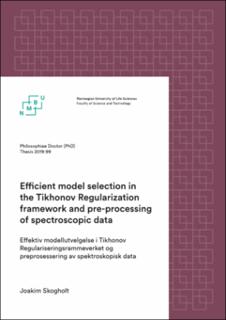| dc.contributor.advisor | Indahl, Ulf Geir | |
| dc.contributor.advisor | Liland, Kristian Hovde | |
| dc.contributor.advisor | Næs, Tormod | |
| dc.contributor.advisor | Ponossov, Arkadi | |
| dc.contributor.author | Skogholt, Joakim | |
| dc.date.accessioned | 2022-12-19T11:33:33Z | |
| dc.date.available | 2022-12-19T11:33:33Z | |
| dc.date.issued | 2019 | |
| dc.identifier.isbn | 978-82-575-1663-5 | |
| dc.identifier.issn | 1894-6402 | |
| dc.identifier.uri | https://hdl.handle.net/11250/3038478 | |
| dc.description.abstract | Machine learning is a hot topic in today's society. Data sets of varying sizes show up in a number of contexts, and learning from data sets is important for answering many questions. There is a plethora of methods that can be used to extract information from data, and in this thesis we consider primarily the Tikhonov Regularization (TR) framework for regularized linear least squares modeling. TR is a very flexible modeling framework, in the sense that it is easy to adjust the type of regularization used as well as including a priori information about the regression coefficients.
The main topic of this thesis is efficient model selection in the TR framework. When using TR regularization for modeling it is necessary to specify one or more model parameters, often called regularization parameters. The regularization parameter can have a significant effect on the quality of the final model, and choosing an appropriate regularization parameter is therefore an important part of the modeling. For large data sets model selection can be time consuming, and it is therefore of interest to obtain efficient methods for selecting between different models. In Paper I it is shown how generalized cross validation can be used for efficient model selection in the TR framework. This discussion continues in Paper III where it is shown how leave-one-out cross validation can be done efficiently in the TR framework. Paper III also suggests a heuristic that can be used for efficient model selection when dealing with data sets with repeated measurements of the same physical sample.
Raw data often needs to pre-processed before useful models can be created. Papers I and II deal with pre-processing and modeling of vibrational spectroscopic data in the extended multiplicative signal correction (EMSC) framework. In the EMSC framework unwanted effects in the data are modeled as multiplicative and additive effects. In Paper I it is shown how the correction of additive effects can be done while creating a regression model in the TR framework and why this can in some cases be advantageous. The multiplicative correction in EMSC is based on a single reference spectrum, but for data sets with very different spectra a single reference spectrum might not be sufficient to accurately correct for multiplicative effects in the measured spectra. Paper II discusses how to extend the EMSC framework to include multiple reference spectra as well as how appropriate reference spectra can be obtained automatically.
Paper IV considers classification using regularized linear discriminant analysis (RLDA). The link between RLDA and regularized regression is used to argue that the efficient validation criteria discussed in papers I and III also can be used for model validation in RLDA. This is tested empirically and the results indicate that good choices of the regularization parameter can be obtained efficiently using a regression-based criterion. | en_US |
| dc.language.iso | eng | en_US |
| dc.publisher | Norwegian University of Life Sciences Ås | en_US |
| dc.relation.ispartofseries | PhD Thesis;2019:99 | |
| dc.rights | Attribution-NonCommercial-NoDerivatives 4.0 Internasjonal | * |
| dc.rights.uri | http://creativecommons.org/licenses/by-nc-nd/4.0/deed.no | * |
| dc.subject | Tikhonov Regularization | en_US |
| dc.subject | Regression | en_US |
| dc.subject | Model selection | en_US |
| dc.title | Efficient model selection in the Tikhonov Regularization framework and pre-processing of spectroscopic data | en_US |
| dc.title.alternative | Effektiv modellutvelgelse i Tikhonov Regulariseringsrammeverket og preprosessering av spektroskopisk data | en_US |
| dc.type | Doctoral thesis | en_US |

